|
Me Sahyadri |
|
July2018 |
|
Volume 5, number 18, # 72 |
|
Mysteries of Maval Caves – Yelghol Cave |
Please use minimum 1280 pixel horizontal screen resolution for viewing. Please be patient while all the images in webpage are loaded. Please do not use the images for any commercial use without permission. Text in Marathi and English is not exact translation. Please give sufficient time to allow the photographs to load. Special thanks to all those who helped me during the compilation and for the help and guidance during the activity. |
|
|
|
|
देशाची आर्थिक प्रगती व्हावी असे सर्व नागरिकांना वाटणे सहाजिक आहे. अर्थकारणामुळे मिळणारा रोजगार, समृद्धी यासाठी सर्वांनाच आर्थिक प्रगती हवी हवीशी वाटते. आर्थिक प्रगती होताना, त्याचा दिर्घकाळात समाजावर, निसर्गावर, वातावरणावर दुष्परिणाम होणार नाही याची काळजी घेणे महत्वाचे आहे. मनुष्याच्या भावी पिढ्यांना पाणी, शुद्ध हवा, योग्य वातावरण मिळत रहावे अशी भावना मनात रुजणे महत्वाचे आहे. वाढत्या आर्थिक प्रगतीमुळे नैसर्गिक संपदेवर ताण येतो. प्रगतीसाठी प्रदुषण होते. जंगले, माळराने, व इतर अधिवास नष्ट होतात. वसुंधरेवर रहाणाऱ्या इतर जीवांचा मात्र मनुष्य फारसा विचार करत नाही. आर्थिक प्रगती करताना, मनुष्य निसर्गाची हानी करत आहे. मुळताच माणसाला निसर्गाचे महत्व समजणे हे सध्याच्या आपल्या प्रगत जीवनशैली मुळे अवघड झाले आहे. आर्थिक प्रगती, समाजाची प्रगती व निसर्ग संपदेची निगा, यांचा समतोल राखणे काळाची गरज आहे.
सह्याद्री (पश्चिम घाट) हा एक नैसर्गिक संपदेचा, वैविध्यतेचा, भौगोलिक व ऐतिहासिक ठेवा आहे. वाढत्या मानवी अतिक्रमणाचा, सह्याद्रीच्या विविध घटकांवर होणारा दुष्परिणाम भविष्यात आपल्यालाच धोका निर्माण करेल, यात शंका नाही. शुद्ध पाणी, हवा व उर्जा, भावी पिढीला मिळण्यासाठी, नंद्यांचे उगम असलेला सह्याद्री व त्याभागातील जंगले टिकवणे महत्वाचे आहे. सह्याद्रीच्या महत्वाच्या घटकांचे महत्व छायाचित्रांद्वारे प्रकट करण्याचा मी येथे प्रयत्न केला आहे. येथील पक्षी, प्राणी, वनस्पती, अधिवास, किल्ले व लेणी अशा विविध विषयांबद्दल आपण समजुन घेऊ.
|
|
As the economic development has taken the center stage, the balance between the environmental sustenance and socio economic development will be under the scanner. As most experts with balanced views have proclaimed, Indian wildlife and ecological system sustenance will be under threat, unless precautions are taken with the help of appropriate research and long term national interests. As we encounter the economic development, many habitats which indirectly or directly help sustainable development will be damaged. The awareness to gauge the success by sustainable development and not by year to year growth is a distant dream any environmentalist will assume in current scenario.
Western ghats, or Sahyadri as we all call it as, is a treasure trove of spectacular landscapes, biodiversity, flora, fauna, some amazing geological wonders and man made monuments. With the increasing pressure from human encroachment, all these elements are under stress and in turn are under depletion. Western ghats should be left untouched by human beings, to protect their future generations from getting short of resources, such as water, energy and clean air. The important elements of western ghats, which need protection are highlighted in the new version of Photo journal, Me Sahyadri Magazine.
|
|
|
| |
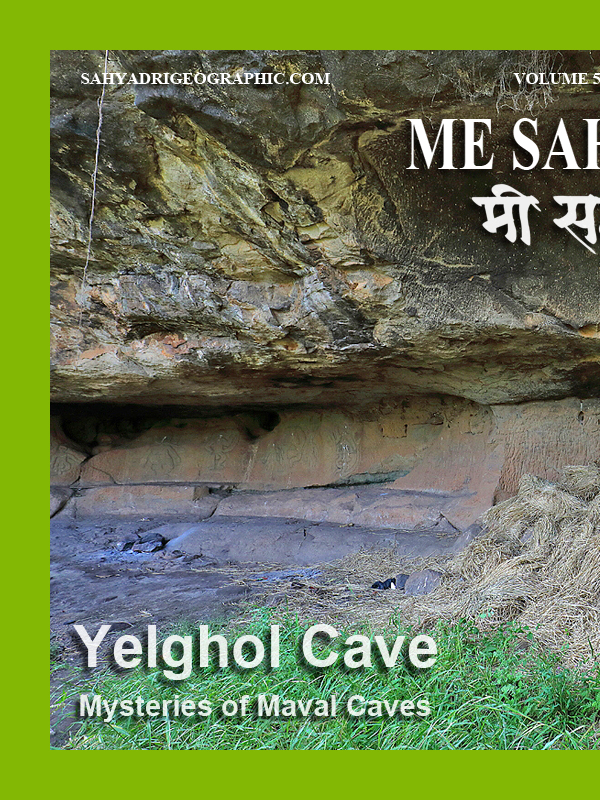 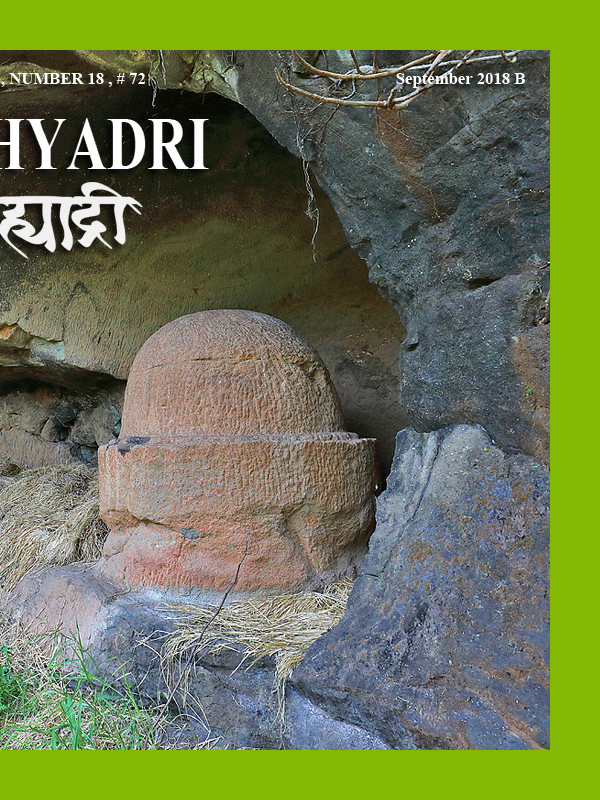
|
| |
| Me Sahyadri – September 2018 B
|
| |
|
|
मावळ लेणी मोहेमेचा सारांश :
मावळातील भाजे, बेडसे आणि कार्ले लेणी अप्रतिम आहेत. त्यामुळे या भागातील इतर लहान लेण्यांकडे फारसे कोणी फिरकत नाही. आम्ही चार समविचारी मित्रांनी मात्र या हरवलेल्या लेण्यांची शोधाशोध करण्याचे ठरवले. साईप्रकाश बेलसरे, निनाद बारटक्के, अमेय जोशी आणि विवेक काळे असा संघ तयार झाला. एकोणीसाव्या शतकात जेम्स बर्जेस आणि जेम्स फर्ग्युसन या दोन इंग्रज विद्वानांनी भारतातील लेणी धुंडाळली. त्यांनी १८८० साली "केव्ह टेम्पल्स ऑफ इंडिया" या पुस्तकाचे प्रकाशन केले. या पुस्तकात मावळातील लहान लेण्यांचा फारसा तपशिल नसला तरी, या मावळातील इतर लहान लेण्यांबद्दल ५-६ वाक्यांमध्ये आम्हाला त्रोटक का होईना माहिती मिळाली. त्यांनी उल्लेख केलेली, काही ठिकाण सापडली, तर काही ठिकाण काहीही केल्या सापडेनात. कदाचित न सापडलेली ठिकाण नष्ट झाली असावीत. पण मोहिमे दरम्यान नविन, ज्या ठिकाणांचा पुस्तकात उल्लेख नव्हता, पण ग्रामीण भागातल्या स्थानिकांना माहिती होती अशी ठिकाण सापडली.
जेम्स बर्जेस आणि जेम्स फर्ग्युसन या दोन इंग्रज विद्वानांनी लिहिलेल्या प्रत्येक शब्दाचा धागा म्हणुन वापर करायचे ठरले. कामांचे वाटप झाले.
शोध मोहिमेत लागणाऱ्या खाऊची सोय करणे, विषय आणि ठिकाणाचा आधी अभ्यास करणे, प्रवासाची सोय करणे, गावकऱ्यांकडे लेण्यांबद्दल चौकश्या करणे, मोहिमे दरम्यान गचपणातुन वाट शोधणे, लेण्याच्या अवशेषांची मोजमाप घेऊन त्याची चित्रे/नकाशे काढणे, छायाचित्रे काढणे, जि. पि. एस. यंत्रावर वाटेबद्दल माहिती नोंदवणे, लेण्यात लहान बारकावे शोधणे, लेण्यांचे विश्लेषण करणे, नोंदी करणे, अशी वेगवेगळ्या प्रकारची काम वाटुन घेण्यात आली.
प्रत्येक ठिकाणी जाताना, घरचा अभ्यास करावा लागला. जुनी पुस्तके, नकाशे धुंडाळले गेले. गावातल्या मित्रांची मदत झाली. गावागावात चौकश्या केल्या. गडद, लेणे, गुहा, कपार, भोगदा, विहार, पांडवांनी एका रात्री बनवलेली गुहा असे अनेक शब्द वापरुन चौकश्या झाल्या. बहुतेक वेळा असे काही नाही इथे ! तुम्ही कुठुन आलात ? असे उत्तर मिळाले. लेणे आहे का इथे कुठे असा प्रश्न विचारला तर आम्हाला बहुतेकांनी कार्ले/बेडसे/भाजे लेण्यांचा पत्ता दिला. पण बकऱ्या, गाई घेऊन डोंगरात फिरणारे गुराखी मात्र दरवेळेला मदतीला धाउन आले. वाटांचे आणि दिशांचे अंदाज मिळाले. जुजबी माहिती घेऊन ठिकाण शोधणे या प्रकाराचा चांगला सराव झाला. कधी काटेरी करवंदींच्या खालुन खुप सरपटाव लागल तर कधी घसाऱ्यावर हात टेकावे लागले.
लेण्यांमध्ये मोठे कोळी (स्पायडर), कातळ पाली, वटवाघळ, मधमाश्या, पाकोळ्या, घुबडं भेटले. आमच्या मुळे त्यांना उगाच त्रास झाला, असा अपराधीपणा वाटला. प्रत्येक शोधमोहिमेला यश आलेच असे नाही. काही ठिकाण सापडली नाहीत. तर काही ठिकाण आमच्याच मनाचे खेळ आहेत असे लक्षात आले. बहुतांश ठिकाणी कोणत्या ना कोणत्या प्रकारची जोखिम होती. वटवाघळ, लेण्यातील धुळ, काळोख, मधमाश्या, काटेरी वनस्पती, घसारा, गुहेतील ऑक्सिजन चा अभावआणि इतर न दिसणारे धोके यावर मात झाली. मोहिमेसाठी, विजेऱ्या, जि. पि. एस., मोजपट्या, दोऱ्या, लेजर यंत्र, नकाशे, गुगल मॅप, जाळीच्या टोप्या या सर्व जंत्रीचा उपयोग झाला. एकूण मिळुन २० नविन अपरिचित ठिकाण/वास्तु पहायला मिळाल्या, मावळाचा भुगोल जरा अजुन नीट लक्षात आला. नविन प्रश्न पडले आणि नविन कोडी सोडवयाला मिळाली. तर्क वितर्क झाले.
|
|
About the Maval Cave exploration :
The main caves in Maval region are so significant that other small hermit caves are often overlooked. We as a team of four like minded friends, decided to explore the Maval region for these small hermit caves. We explored and found few beautiful places. The very concept of creating a hermit cave somewhere high up in the hills is fascinating. These places often are full of tranquility and nothing else. With very little architectural evidences and clues, the academicians have obviously ignored these places. It was James Fergusson and James Burgess, during their exhaustive study of “Cave temples of India, 1880” mentioned few of these hermits in Maval region of Pune district. With the little clues and exhaustive investigation, team of four members, Saprakash Belsare, Amey Joshi, Ninad Bartakke and Vivek Kale started the exploration. The journey to locate, trek and analyse these hermit caves itself was fascinating. We met many villagers who were unaware of these places, but also met few shephards who were precisely aware of the hermits and gave us tentaive guidance.
There is a very brief mention about the misceleneous caves of Maval by James Fergusson and James Burgess in their work. Based on available information we decided to search these caves and monuments. The activities were planned. The food, travel , track exploration in difficult and routes full of foliage, enquiring the villagers about the caves, taking measurements and drawing skecthes and maps, photography, GPS data collection, making notes and analysing the information, observing the minor details of the caves etc activites were distributed amongst the team members. We met many bats, owls, geckos, lizards, large spiders, martins, honeybees during the treks. Often we felt sad that we disturbed them to see the caves. Most of these places are hazardous due to pitch darkness, bats, dust, thorny plants, honeybees, low oxygen level in caves and rock patches etc. Not all the attemps were successful. Sometimes we could not find the intended places and sometimes we realised that the cave was just our imagination and did not exist. Nevertheless we saw about 20 new strange caves/monuments during the exploration. The high intensity torches, GPS tool, measuring tapes and measuring laser tool, Honeybee protection caps, maps, google maps, photographs etc were useful during the mission.
In this photoessay, I have compiled the information and photographs of Yelghol Cave, Maval, amazing, simple but questions-thrower cave.
|
|
|
| |
  |
| The banner has been published here to improve the awareness of the trekkers and tourists visiting the various mountain forts, mountains in north western ghats. Please avoid accidents, by following good outdoor ethics such as no swimming in cisterns at mountain forts, no rock climbing without proper technical equipment and expertise. Please do not adventure, trek with any group or individually without understanding the risks associated. The frequency of the solo trekker fatalities have increased recently. Please strictly avoid solo treks. Please also avoid treks to mountains in large commercial groups, as it leads to damage to biodiversity of these high elevation ecological islands. Please respect the wildlife and biodiversity of the region. This has become more important as the ever increasing human interference is leading to severe damage to fragile ecosystems. Please be aware of the wildlife and biodiversity of the mountains before visiting these mountains. Please follow outdoor ethics. Follow ASI and Forest department rules. The concept of use of symbols for outdoor ethics was conceived and designed by "Sahyadri Trekker Bloggers Group". |
| |
|
|
| |
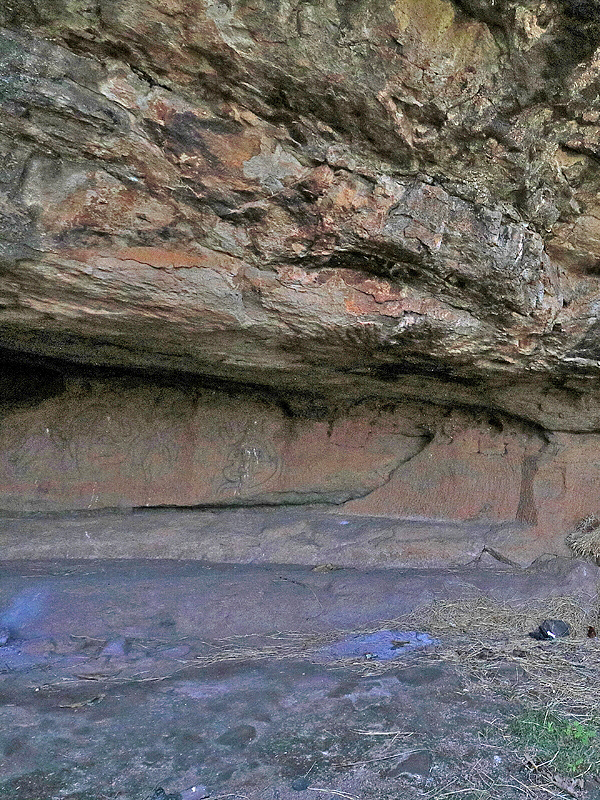  |
| |
| 1. Yelghol Cave, Maval Tehsil, Pune district, Maharashtra, India |
| |
|
|
पुणे जिल्ह्यात, मावळ तालुक्यात कार्ले, भाजे आणि बेडसे येथे डोंगरांवर दगडात लेणी कोरली आहेत. मावळात या भागात, इतरत्र सुद्धा लहान विहार आणि लेणी आहेत. यातील एक लहान अपरिचित पडके लेणे बेडसे लेण्याजवळ, दक्षिणेला येळघोळ गावाजवळ डोंगरात आहे. जेम्स फर्ग्युसन आणि जेम्स बर्गेस या इंग्रज विद्वानांनी भारतातील लेण्यांचा रितसर अभ्यास करुन केव्ह टेंपल्स ऑफ इंडिया शीर्षकाचे पुस्तक १८८० साली प्रकाशित केले. त्यांनी नमुद केलेल्या मावळातील लहान लेण्यांमध्ये येळघोळ चा उल्लेख आढळत नाही.
|
|
Around the famous Karle, Bhaje and Bedse Caves in Maval Tehsil of Pune district there are many smaller hermit caves in the hills. One of the interesting wonderful hermit is located in the hill near village called as Yelghol. James Fergusson and James Burgess the noted explorers of Buddhist rock cut caves, around Pune has not mentioned about this place in his book “Caves temples of India (1880)”.
|
|
|
| |
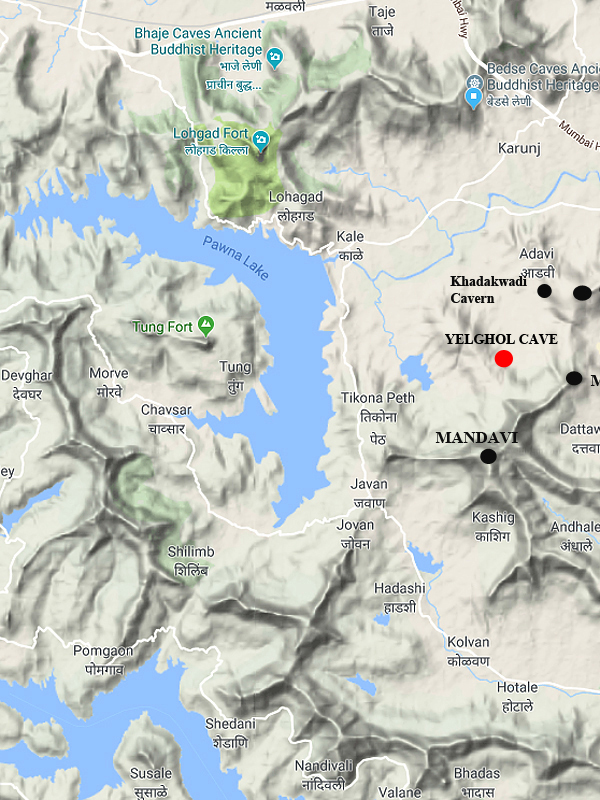 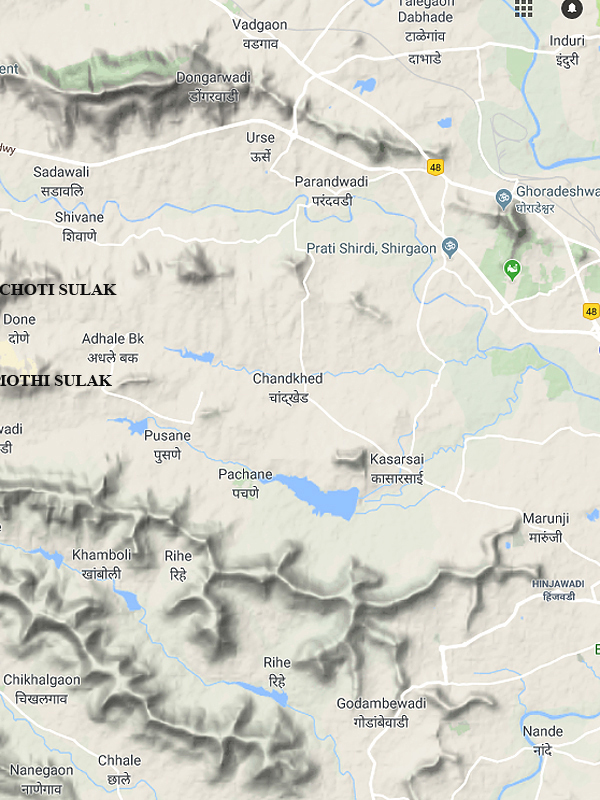 |
| |
| 2. Map of region, Yelghol Cave, Maval Tehsil, Pune district, Maharashtra, India |
| |
|
|
येळघोळ गाव महाराष्ट्र राज्यात, पुणे जिल्ह्याच्या मावळ तालुक्यात पवन मावळात वसलेले आहे. दोन लहान डोंगर रांगांच्या मध्ये हे गाव वसलेले आहे. मावळात रिहे, आंधळे नावाची दोन गाव आहेत. या गावांच्या भवताली दोन जुळ्या समांतर डोंगररांगा आहेत. यातील एक डोंगररांग माण गावापासुन वायव्येकडे ज्ञानपुरीच्या मांडवी डोंगरापर्यंत तर दुसरी डोंगररांग घोटवडे गावापासुन वायव्येकडे ज्ञानपुरीच्या मांडवी डोंगरापर्यंत पोहोचली आहे. या दोन रांगा मांडवीच्या डोंगराला एकत्र आल्या आहेत. मांडवी पासुन पुन्हा या डोंगरांना शाखा फुटल्या आहेत. एक शाखा पश्चिमेकडे तिकोना किल्याकडे तर दुसरी शाखा पुर्वेकडे छोटी आणि मोठी सुळुक या जोड गोळीकडे, पवनेकाठी आर्डव गावापर्यंत पसरली आहे. यातील छोटी सुळुक आणि मोठी सुळुक या डोंगरांच्या भागात डोंगरात येळघोळ कपार-लेणे आहे. याच भागात खडकवाडी गावा जवळ डोंगराच्या कुशीत धबधब्याजवळ एक नैसर्गिक कपारीत खडकवाडी कपार लेणे आहे आणि येळघोळ गावा जवळ डोंगराच्या कुशीत धबधब्याजवळ एक नैसर्गिक कपारीत येळघोळ कपार लेणे आहे.
येळघोळ कपार लेणे बौद्ध लेणे आहे, हे येथील स्तुपावरुन स्पष्ट होते. खडकवाडी कपार लेणे येळघोळ कपार-लेण्याच्या उत्तरेकडे अंदाजे २.५ किमी अंतरावर संमांतर डोंगरावर आहे.
|
|
Yelghol is a village in Maval Taluka in Pune district in the state of Maharashtra in India. The village is located at the base of the hill range on the Deccan plateau. There are two small twin hill ranges in Maval which flank, Rihe and Andhale villages. These twin hill ranges combine together at Mandvi hill. There are two extensions to this range. The west extension has Tikona fort. The east extension has twin hills called Mothi Sulak (literal meaning in Mararthi : Large pinnacle) and Choti Sulak (literal meaning in Mararthi : Small pinnacle). The hill range between Mothi and Choti Sulak is extended to north in Pawana river basin. This region is called as Pawana river basin, Pawana Maval. In Pavana Maval, there are known caves at Bedse, Tikona, Khadakwadi and Yelghol. The caves at Bedse and Yelghol are known Buddhist caves.
|
|
|
| |
 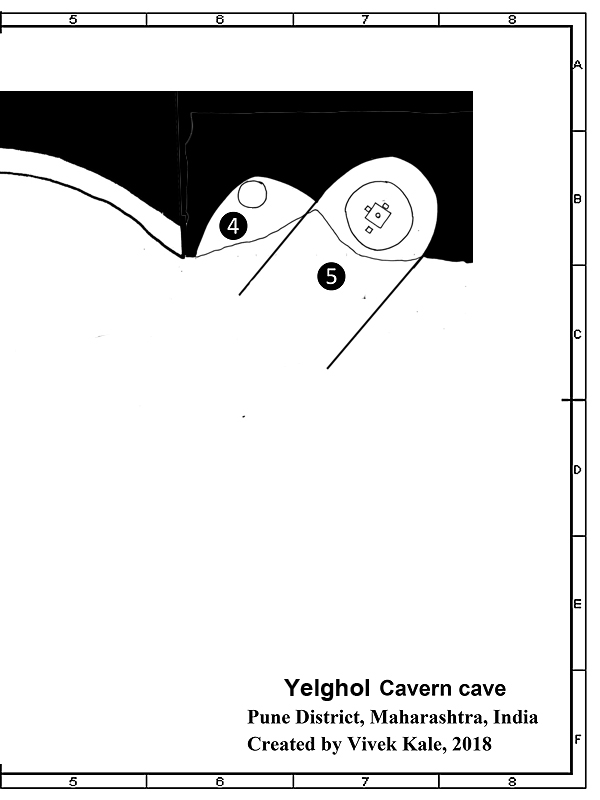 |
| |
| 3. Layout - Yelghol Cave, Maval Tehsil, Pune district, Maharashtra, India |
| |
|
|
येळघोळ गावाच्या पश्चिम दिशेला, गावाच्या पातळीपासुन थोडे उंचीवर डोंगराच्या कुशीत धबधबा आहे. धबधब्याच्या उत्तरेकडे एक नैसर्गिक कपार तयार झाली आहे. कपार अंदाजे १५ मीटर रुंद, ५ मीटर लांब, आणी २.-३ मीटर उंच आहे. कपारीच्या एका बाजूला धबधबा आहे. येथील दगड सच्छिद्र असुन त्याला भेगा आहेत. कपारीच्या आत मागच्या भिंतीमागे, लहान दगड आणि दगडा दगडा अध्ये पोकळ्या अशी नैसर्गिक रचना आहे. खोदायला सोपे जाईल म्हणुन मुळ कपारीचा वापर लेणे बनवण्यासाठी केला आहे. लेण्याच्या बाजूला पाण्याच्या प्रवाहात लहान मोठया कोसळलेल्या शिळा पडलेल्या आहेत.
|
|
Cavern: The natural cavern is located near the Yelghol village, on the west side at little elevation above the village level. The cavern is about 15 meter wide and 5 meter deep, from front to back crevice wall. At the front the cavern is about 2.5 to 3 meter in height. There are chisel marks on the ceiling. The ceiling is irregular and is not flat. The part of the back of the cave is chiselled to make a flat vertical walls. The rest of the back of the cave has deep crack with voids in the crack, which are natural. The backside crack has natural structure with lots of voids and rocks.
|
|
|
| |
 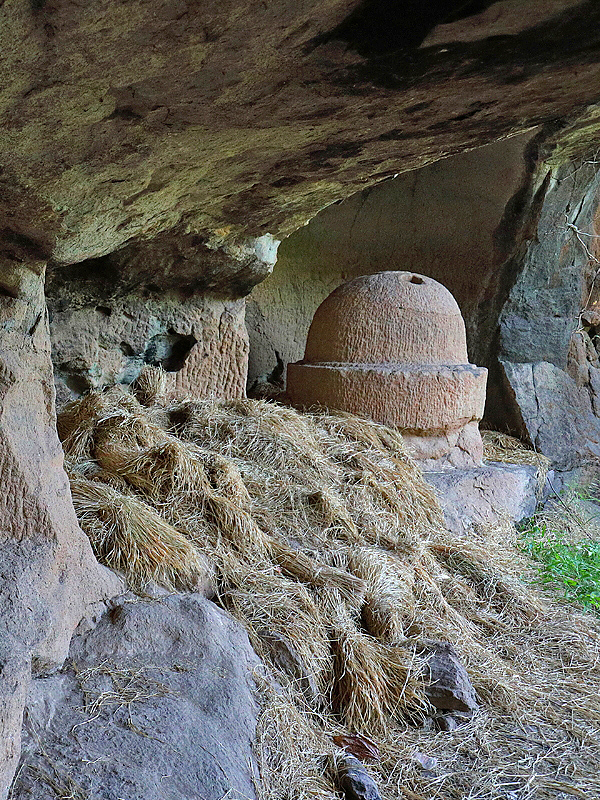 |
| |
| 4. Yelghol Cave, Maval Tehsil, Pune district, Maharashtra, India |
| |
|
|
| |
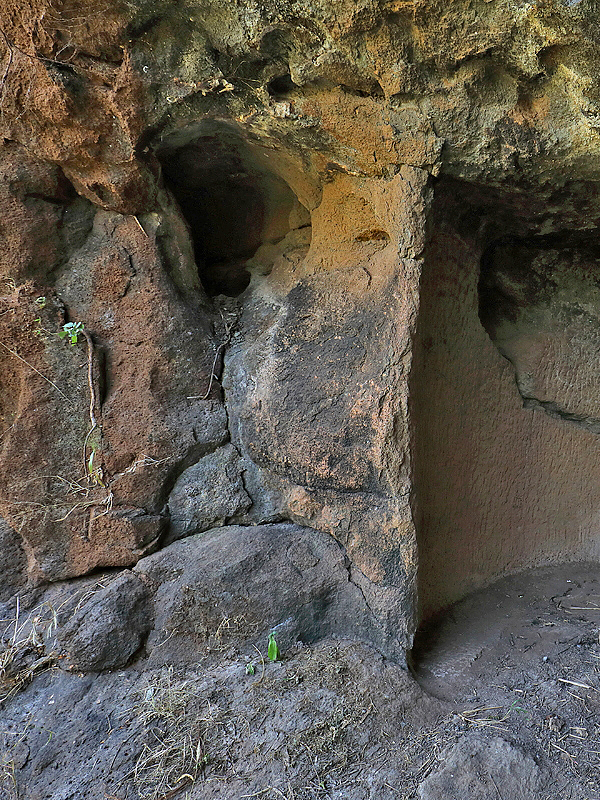 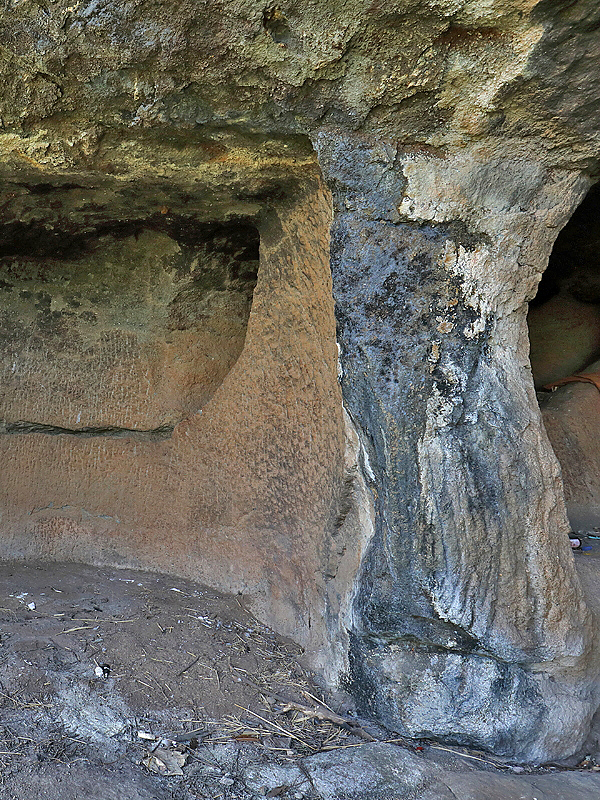 |
| |
| 5. Circular chamber/chaityagriha, Yelghol Cave, Maval Tehsil, Pune district, Maharashtra, India |
| |
|
|
येळघोळ कपार लेणे मुख्य व्यापारी मार्गाजवळ नसले तरी हे कपार लेणे, बेडसे आणि खडकवाडी या दोन लेण्यांच्या जवळ आहे. हे कपार लेणे तिकोना आणि ज्ञानपुरी खिंडीजवळ आहे. बेडसे आणि येळघोळ या बौद्ध लेण्यांचा या लेण्याशी संबंध असावा. खडकवाडी कपार लेणे आणि येळघोळ कपार लेणे यातील बैठकांची (बाकांची) रचना एक सारखी वाटते. या व्यतिरिक्त खडकवाडीच्या कपार लेण्यात आढळणारे दंडगोलाकृती लेण्याचे अवशेष आणि येळघोळ कपार लेण्यात आढळणारे संपुर्ण दंडगोलाकृती लेणे यात साधर्म्य आहे. खडकवाडीच्या दंडगोलाकृती लेण्याची पडझड झाली आहे. लेण्यासमोरे पडलेल्या मोठया दगडांवरुन पडझड झाल्याचे स्पष्ट होते. येळघोळ चे दंडगोलाकृती लेणे बर्यापैकी शाबूत आहे. मावळात अशा दंडगोलाकृती लेण्यांची कमी नाही. जेम्स फर्ग्युसन, जेम्स बर्गेस आणि एस. नागराजु यांच्या मते असे लेणे स्तुपासाठी बनवले असावे. मावळातल्या काही लेण्यात असे दंडगोलाकृती चैत्यगृह आहेत. बेडसे, भाजे (#२६) येथे अशा दंडगोलाकृती चैत्यगृहात कोरलेला स्तुप आहे. तर भाजे(#२४), शिलाटणे, येळघोळ, वाळख, आणि खडकवाडी येथे अशा दंडगोलाकृती चैत्यगृहात कोरलेला स्तुप नाही. याचा अर्थ येथे दगड विटांपासुन बांधलेला किंवा लाकडाचा बांधीव स्तुप असावा. आज मात्र या ठिकाणचे दंडगोलाकृती चैत्यगृह लेणे रिकामे आहे. मावळातल्या विविध दंडगोलाकृती लेण्यांमध्ये काही स्तुप असलेल्या आणि स्तुप असलेल्या लेण्यांचा व्यास एकसारखाच आहे. मावळातल्या या दंडगोलाकृती लेण्यांव्यतिरिक्त कोकणात कोंडिवते, कान्हेरी आणि जुन्नर जवळ तुळजा लेणी येथे दंडगोलाकृती लेणे (चैत्यगृह) आढळते. येळघोळ चे दंडगोलाकृती चैत्यगृह येथे बनवलेले पहिले लेणे असावे. येथील इतर काम नंतर झाले असावे.
|
|
The cavern is located in interior part of Pavana Maval and is not located on any major trade route. However the caves are in vicinity to the Bedse and Khadakwadi caves. The caves are also located close to the Tikona and Dnyanpurwadi pass. The vicinity to Khadakwadi and Bedse, which have been clearly identified as Buddhist caves, suggests possible association of Yelghol excavation with other caves of this region. The pattern in which the bench have been carved at Yelghol and at Khadakwadi has similarities.
The circular chamber is similar to what can be seen at several other caves of the region including that at Khadakwadi, Bhaje#24, Bedse, Shilatane, Walakh. The cylindrical chaityagriha with carved stupa can be seen at Bedse and Bhaje#26. While at Bhaje#24, Yelghol, Walakh, Shilatane and Khadakwadi the cylindrical chaityagriha is empty. Interestingly there are few of these cylinrical chambers with and without stupa with exactly same diameter.
. As per James Fergusson and James Burgess, such chambers were probably used as the place of worship (with structural or wooden stupa), as evident from several other locations in Maval. Such cylindrical chaityagriha are also seen at Kanheri, Kondivate in Konkan and at Tulaja caves near Junnar.
|
|
|
| |
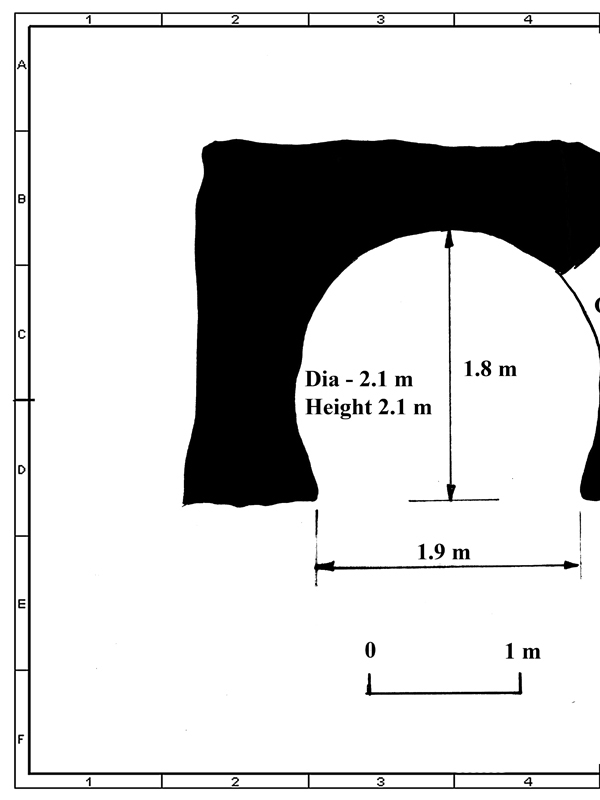 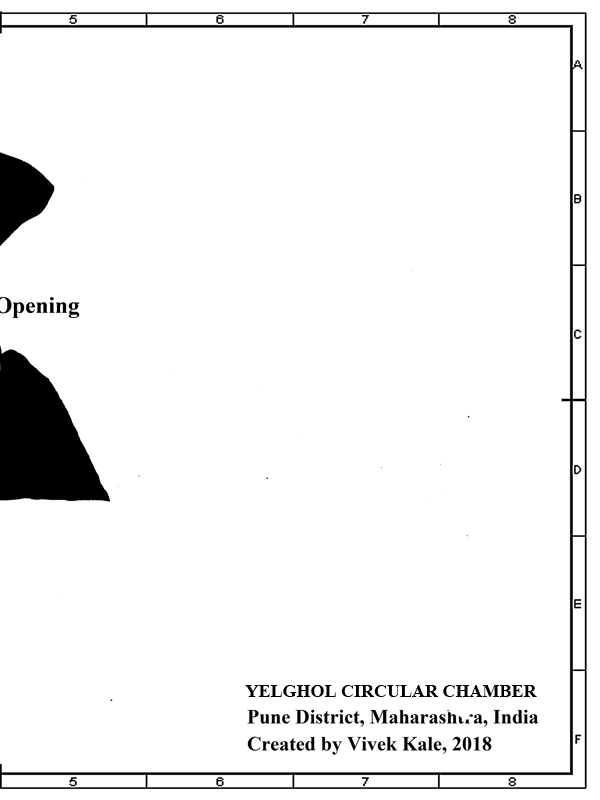 |
| |
| 6. Layout of Circular chamber/chaityagriha, Yelghol Cave, Maval Tehsil, Pune district, Maharashtra, India
|
| |
|
|
| |
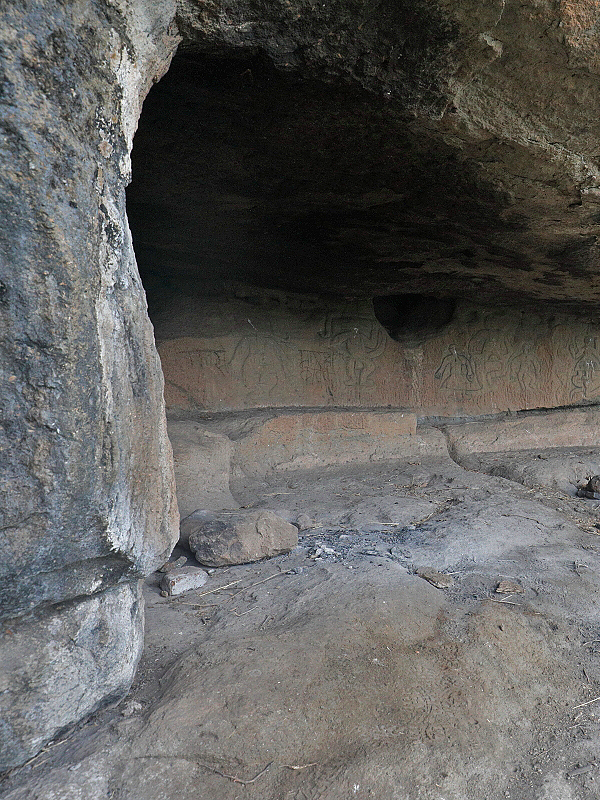 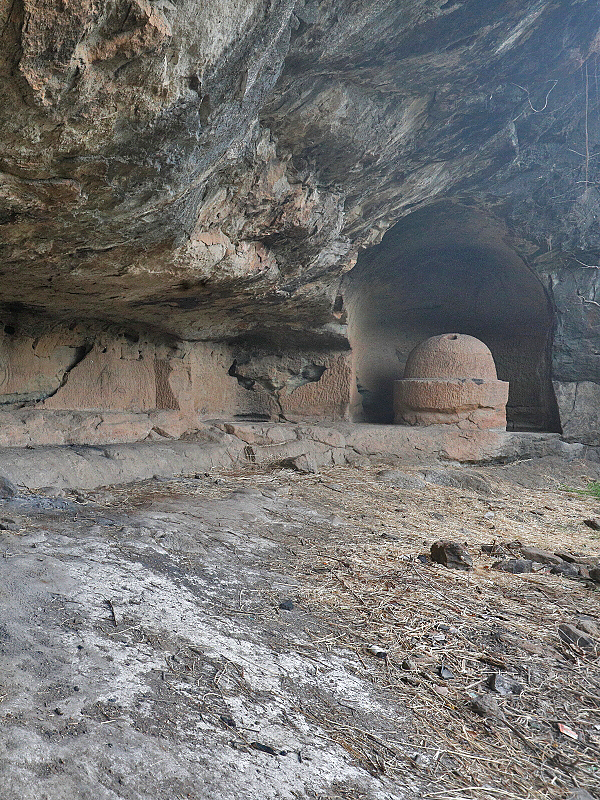 |
| |
| 7. Long bench, Yelghol Cave, Maval Tehsil, Pune district, Maharashtra, India
|
| |
|
|
| |
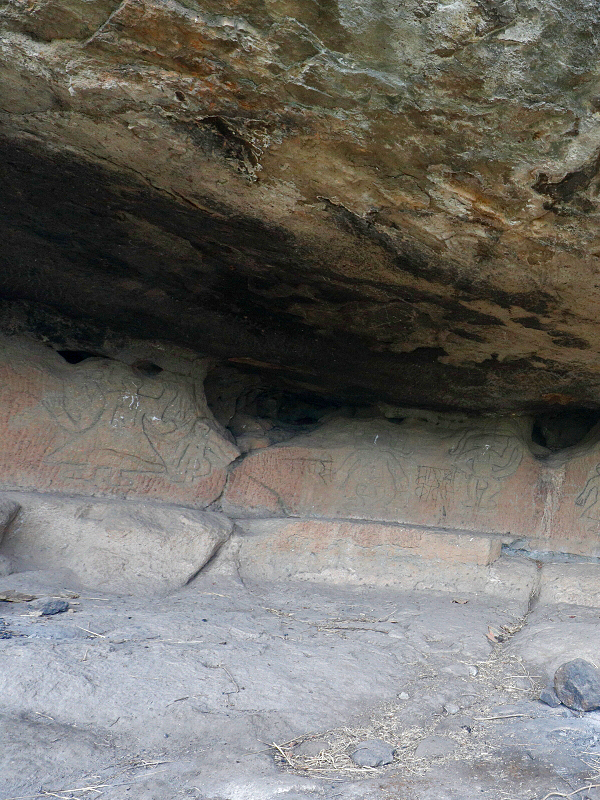 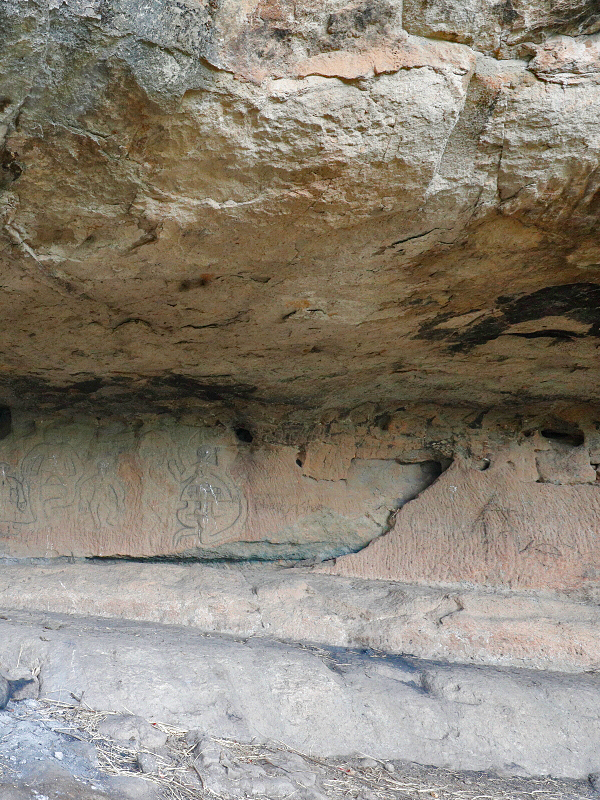 |
| |
| 8. Long bench,Yelghol Cave, Maval Tehsil, Pune district, Maharashtra, India
|
| |
|
|
येळघोळ च्या लांब बाकाकडे पहाता येथे खूप उपासक जमा होत असावेत. अभ्यासासाठी किंवा एखाद्या धार्मिक विधी साठी ते जमा होत असावेत. येथे अंदाजे २०-२५ उपासक बाकावर बसू शकतील एवढी या बाकाही रुंदी आहे.
|
|
The long bench at Yelghol suggests that many people used to gather here either for some ritual or for some function.
|
|
|
| |
  |
| |
| 9. Long bench, Yelghol Cave, Maval Tehsil, Pune district, Maharashtra, India |
| |
|
|
| |
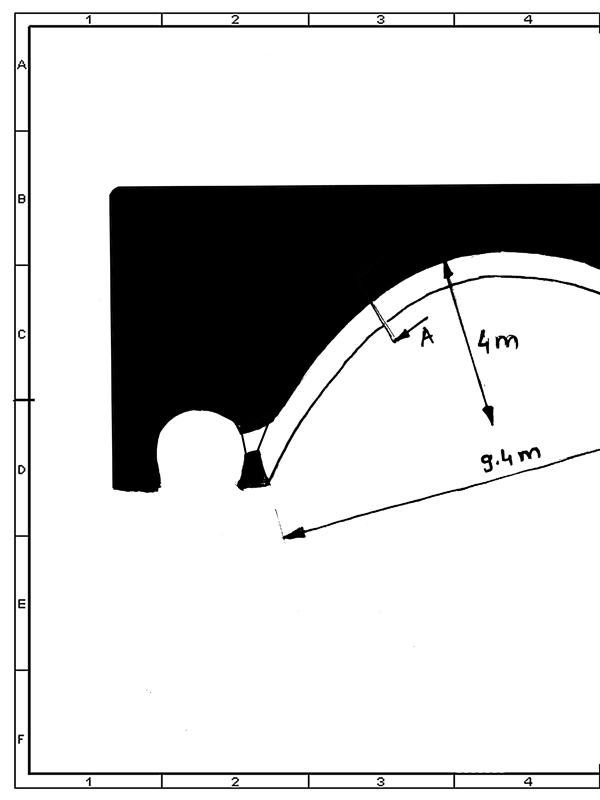 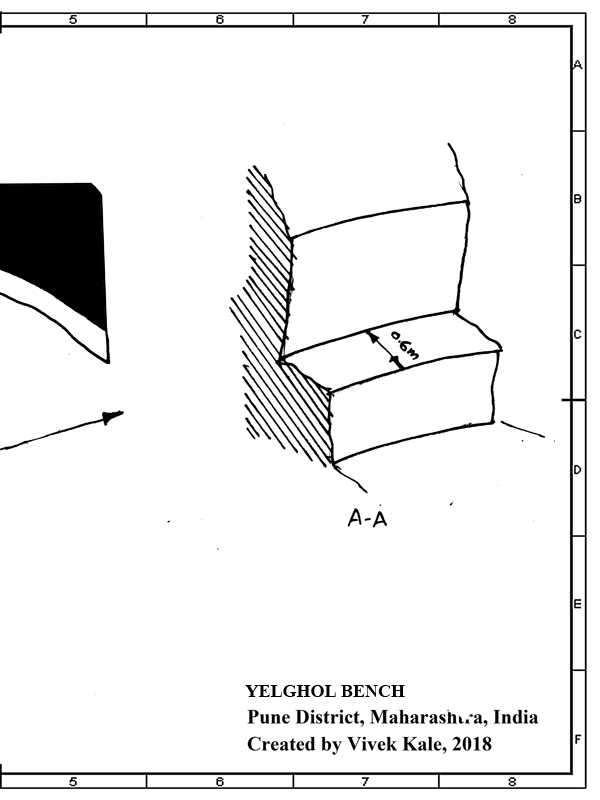 |
| |
| 10. Layout of Long bench, Yelghol Cave, Maval Tehsil, Pune district, Maharashtra, India |
| |
|
|
| |
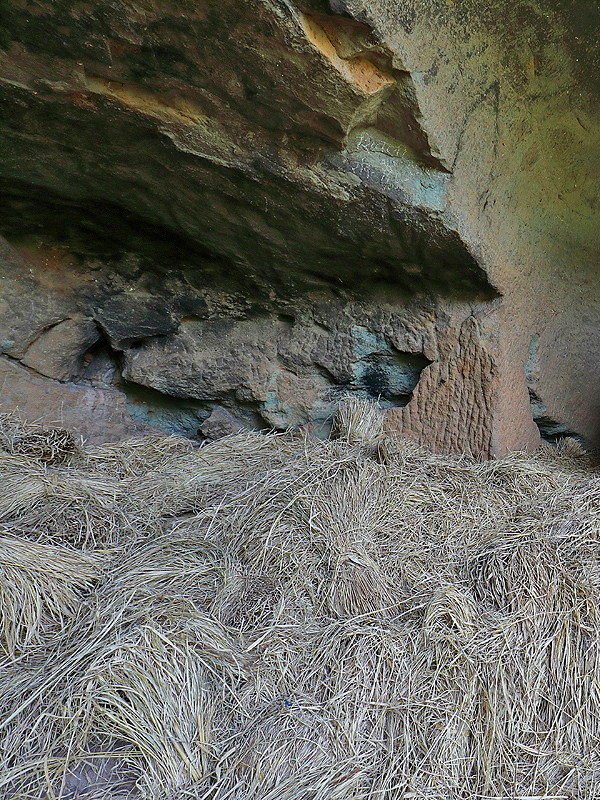 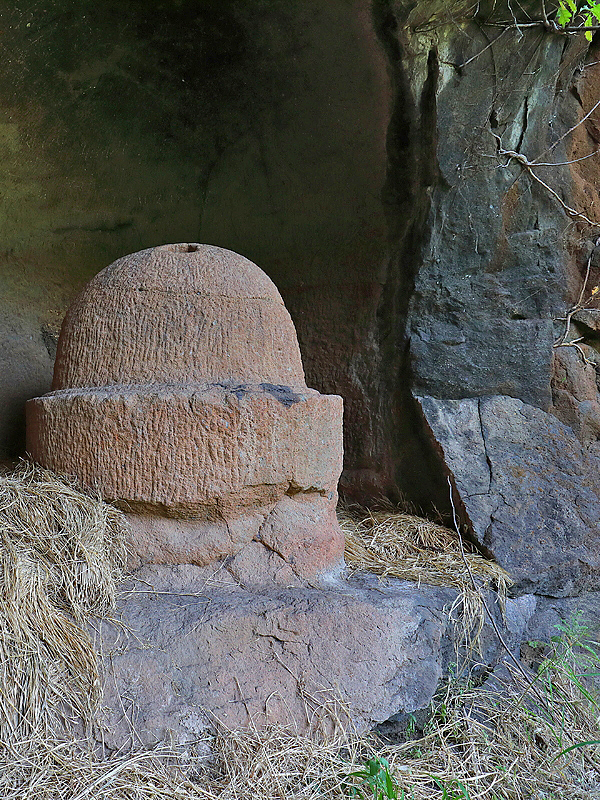 |
| |
| 11. Stupa, Yelghol Cave, Maval Tehsil, Pune district, Maharashtra, India |
| |
|
|
येळघोळ च्या कपार लेण्यात उजवीकडे (उत्तरेकडे) स्तुप आहे. स्तुपाच्या बाजूला एक दगडात कोरलेला रांजण (गोल टाके) आहे. स्तुपावर हर्मिका नाही. कदाचित पूर्वी येथे हर्मिका आणि यष्टी असावी. स्तुपावर मध्यभागी एक भोक आहे. येथे कदाचित हर्मिका आणि यष्टी असावी. या व्यतिरिक्त स्तुपावर तीन चोकोनी भोक आहेत. यात कदाचित त्या काळात येथे असलेल्या भदंत किंवा महत्वाच्या माणसांची आठवण म्हणून त्यांचे शारीरिक अवशेष ठेवले असावेत. येळघोळ लेणे त्या काळात महत्वाचे असावे. स्तुपावर कोणतेही नक्षीकाम नाही. स्तुपावर वरच्या बाजूला छतावर काही महत्वाच्या खुणा आढळतात. या ठिकाणी लाकडाचा चैत्यगृह असावा. छतावर अर्धगोलाकार कोरीव काम आहे. स्तुपासमोर च्या जमिनीत आज फारशा खुणा नसल्या तरी येथे लाकडी चैत्यगृह असावा असे वाटते. याव्यतिरिक्त येथे एक दगडात कोरलेला रांजण आहे. असाच हुबेहूब रांजण शिलाटणे लेण्यात आढळतो. यात कदाचित पाणी अथवा धान्य साठवून ठेवत असावेत. गोल टाक्यांची परंपरा जुनी असावी. नंतर च्या काळात टाकी चौकोनी झाली.
|
|
There is a stupa on the right side (north) of the cavern. The stupa is simple without any vedika pattern carved on it. The Stupa do not have integral Hermika. There is a provision of fitment of Hermika, Yashti at the top. The grooves and hole for the same can be seen on the top of the Stupa. There are few additional holes in which the relics were kept. These holes are three in numbers. This suggests that relics of atleast 3 scholarly people were kept in these holes. This suggests that the Yelghol cave must have been used for long time. There are no inscritions here. The fascinating part of the stupa here is a ceiling carving as if there was a structural chaityagriha around the Stupa, The ceiling clearly show the crude asphidal shape. The structure may have been prepared out of wood. This is a unique design of chaityagriha as it has some part carved and the extension was probabaly structural.
The other fascinating aspect of the Yelghol cave is presence of an underground rock cut cistern either used for the storage of grains or the water. The cistern is almost similar to that at Shilatane and probabaly at Walakh. The cistern is circular at mouth and has provision of putting the lid above it. It is filled with rocks and is difficult to guage its depth. The neck and outer dimensions are similar to that of Shilatane cistern.
|
|
|
| |
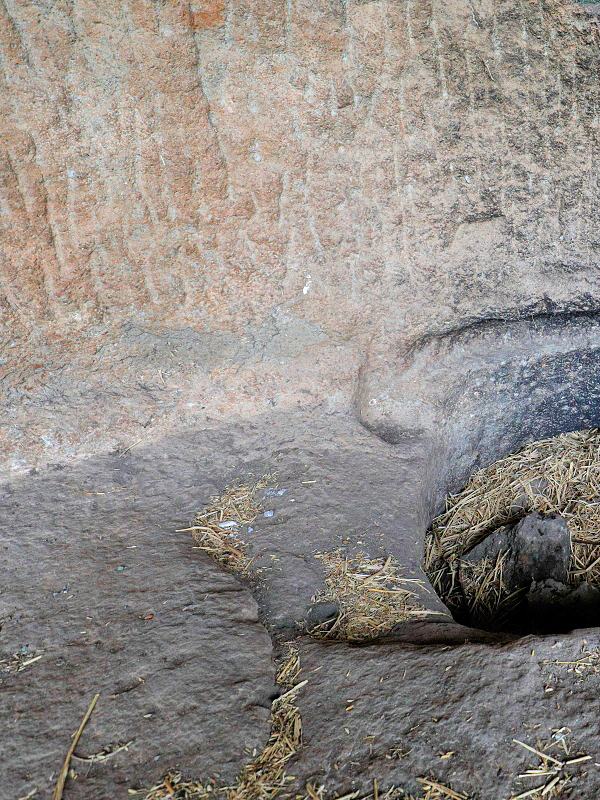 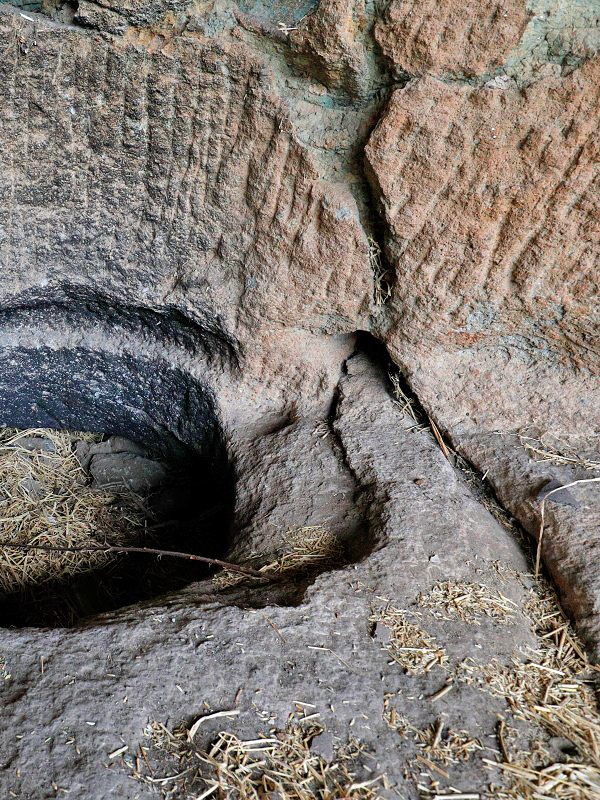 |
| |
| 12. Cistern, Yelghol Cave, Maval Tehsil, Pune district, Maharashtra, India |
| |
|
|
| |
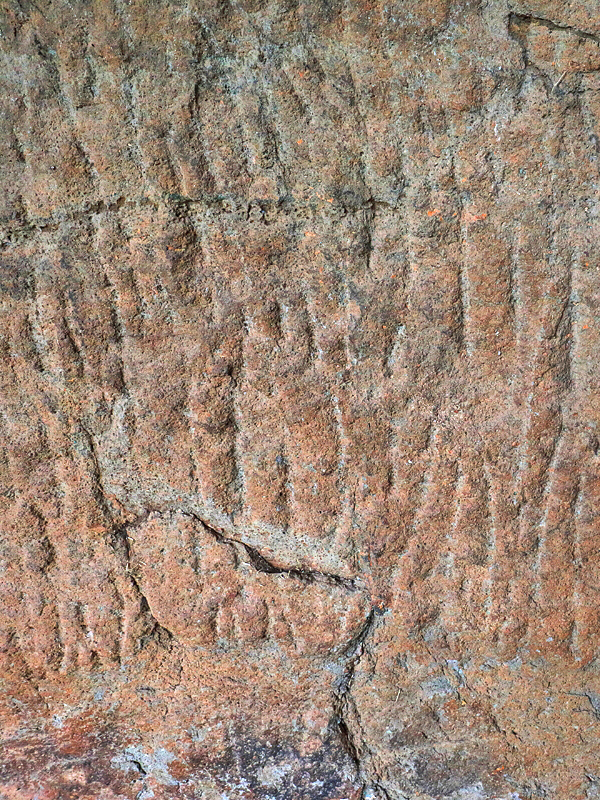 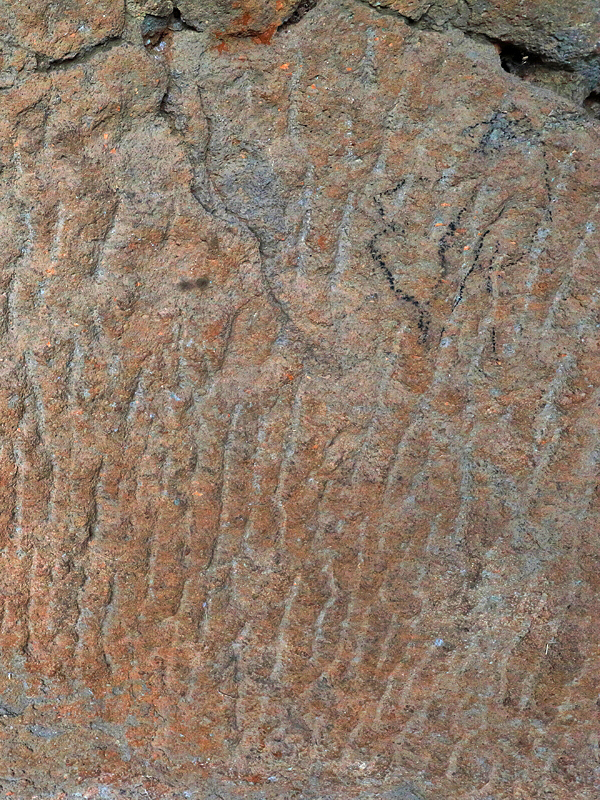 |
| |
| 13. Chisel marks, Yelghol Cave, Maval Tehsil, Pune district, Maharashtra, India |
| |
|
|
| |
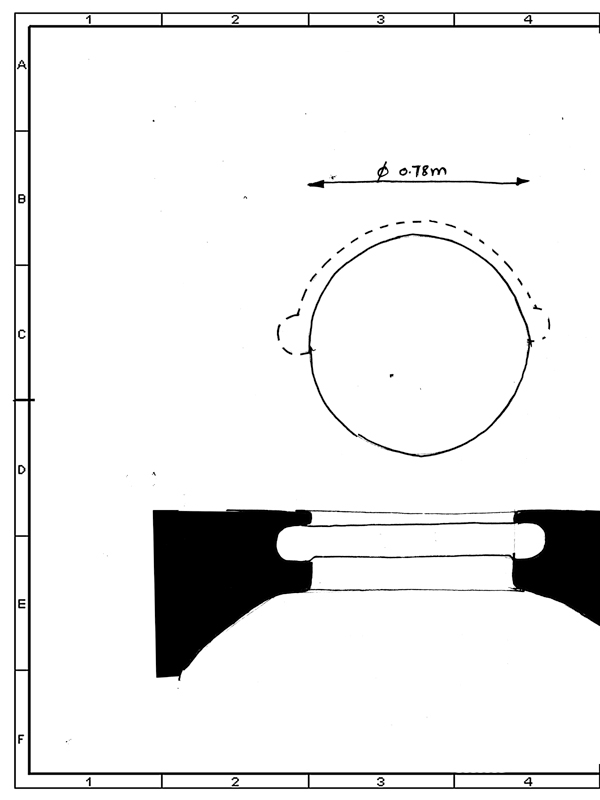 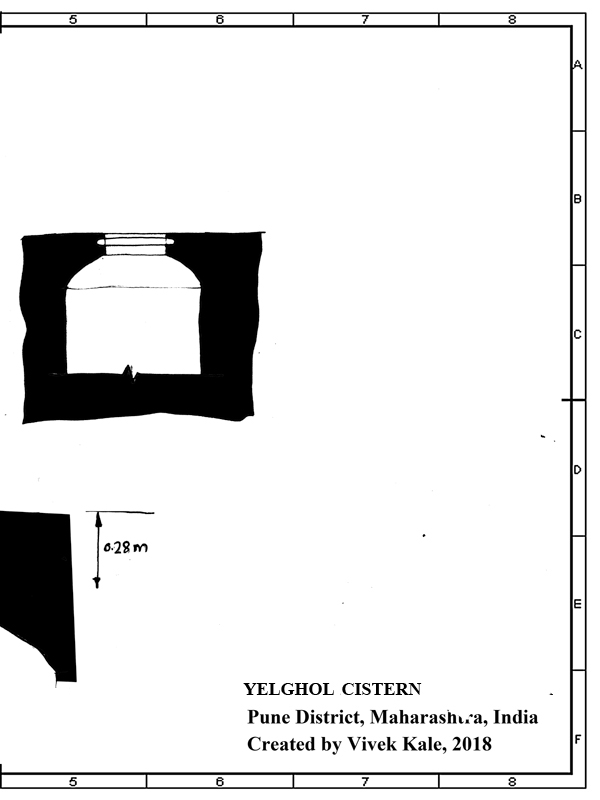 |
| |
| 14. Layout of cistern, Yelghol Cave, Maval Tehsil, Pune district, Maharashtra, India |
| |
|
|
| |
 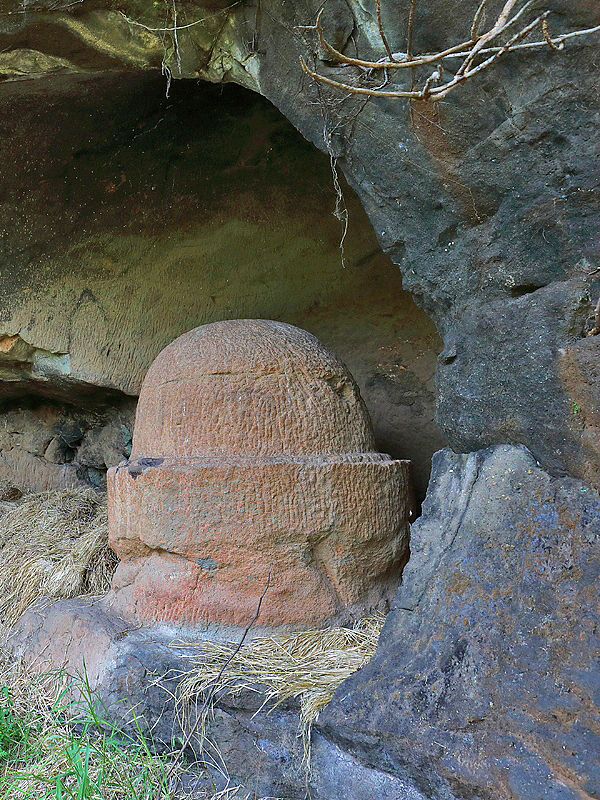 |
| |
| 15. Stupa/Chaitya, Yelghol Cave, Maval Tehsil, Pune district, Maharashtra, India |
| |
|
|
| |
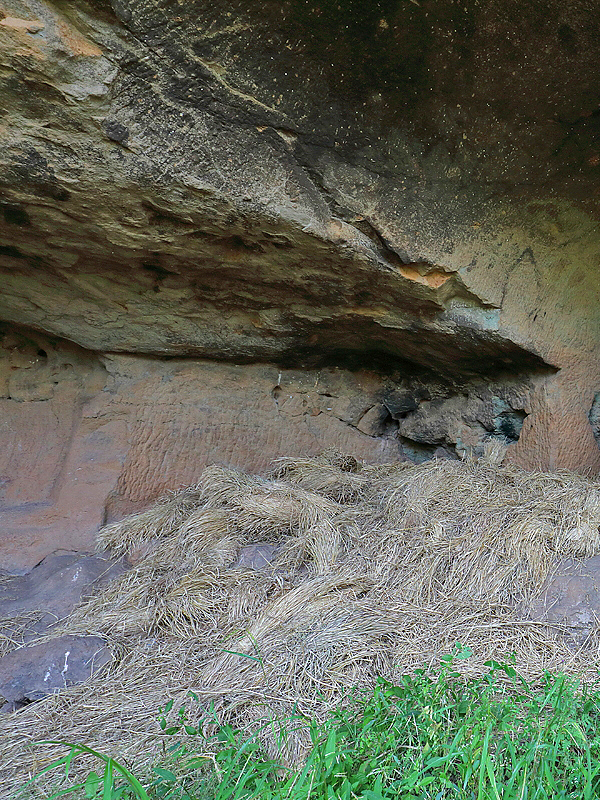  |
| |
| 16. Stupa/Chaitya,, Yelghol Cave, Maval Tehsil, Pune district, Maharashtra, India |
| |
|
|
| |
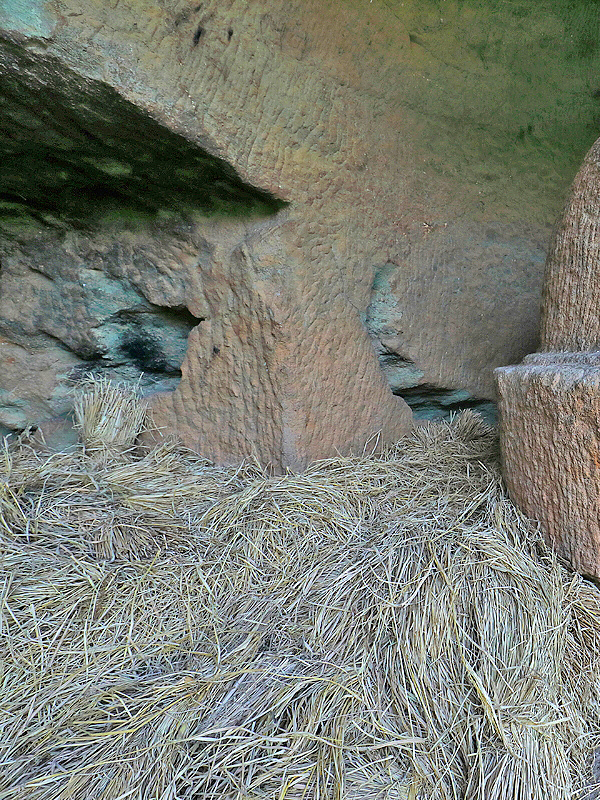 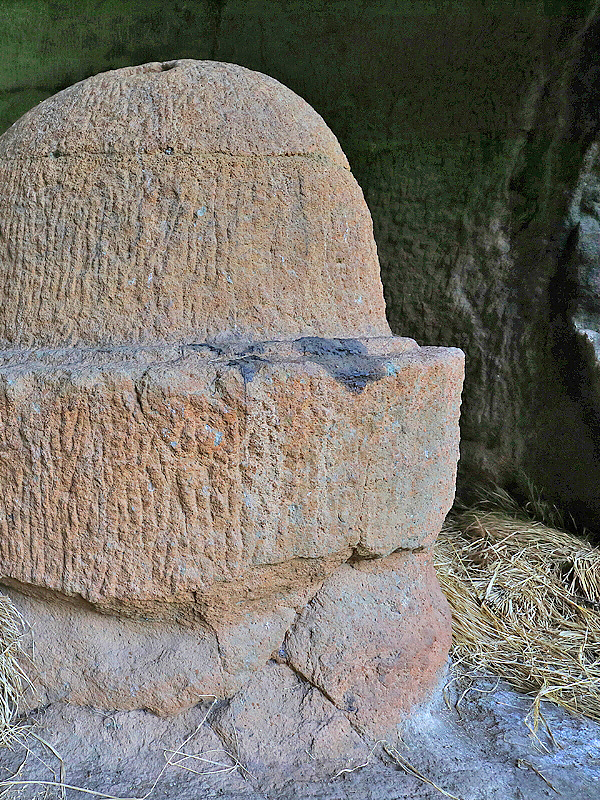 |
| |
| 17. Stupa/chaitya, Yelghol Cave, Maval Tehsil, Pune district, Maharashtra, India |
| |
|
|
| |
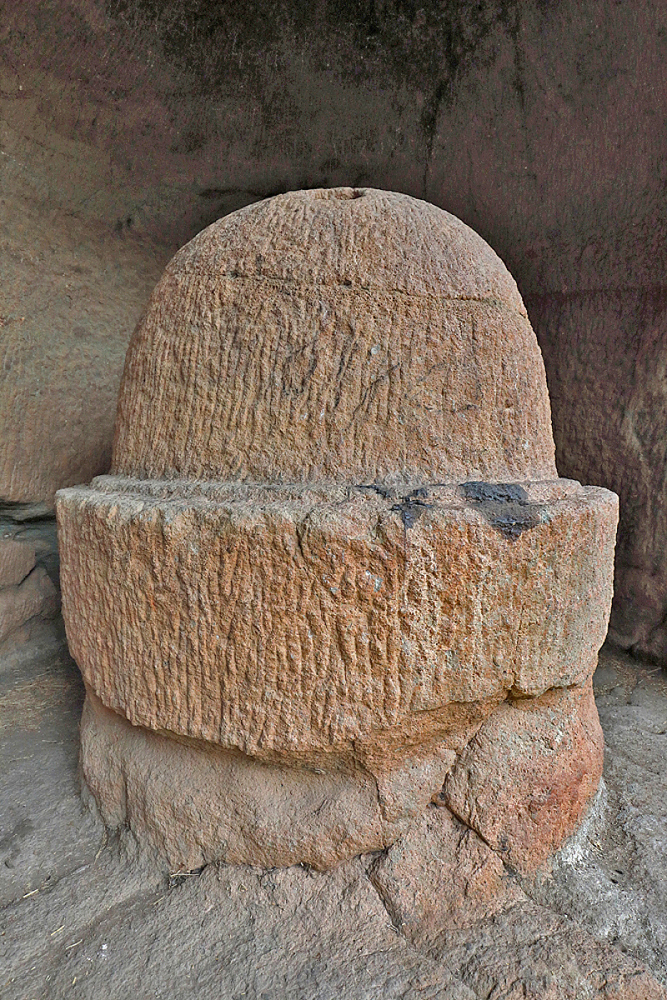 |
| |
| 18. Stupa/chaitya, Yelghol Cave, Maval Tehsil, Pune district, Maharashtra, India |
| |
|
|
| |
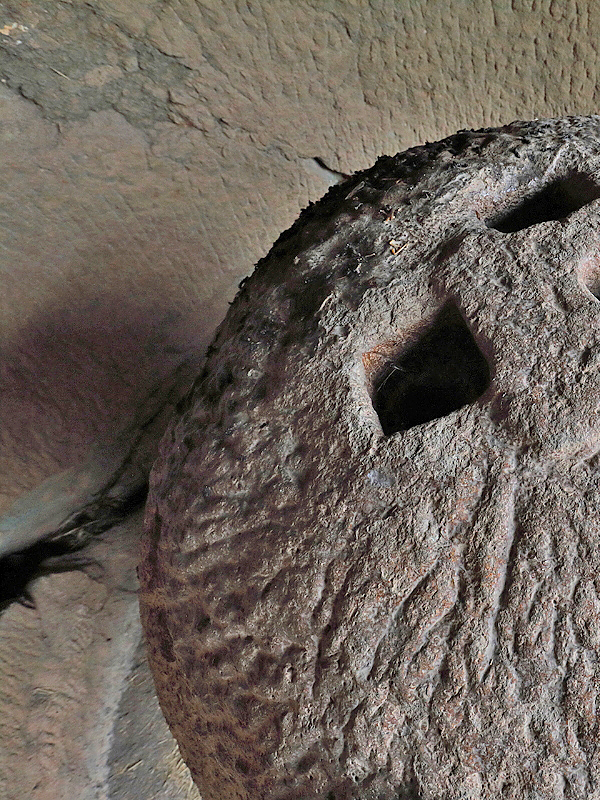 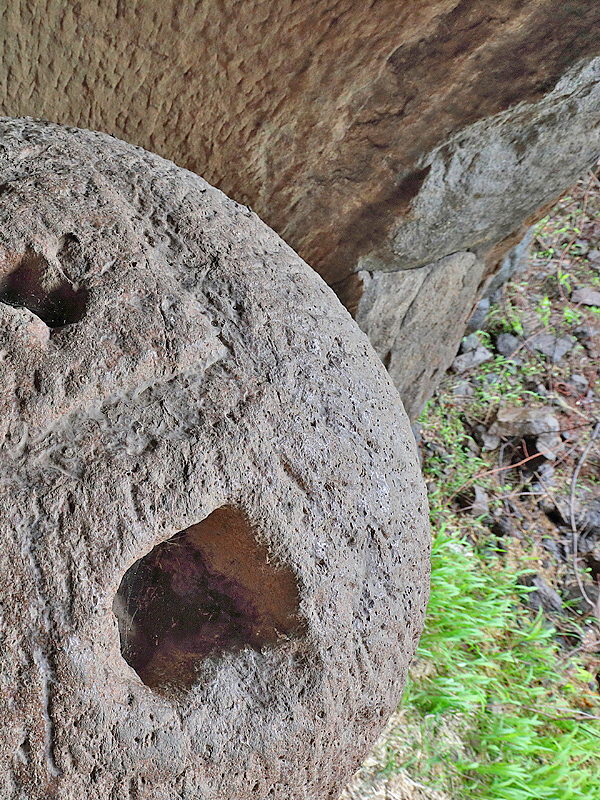 |
| |
| 17. Stupa/chaitya, Yelghol Cave, Maval Tehsil, Pune district, Maharashtra, India |
| |
|
|
| |
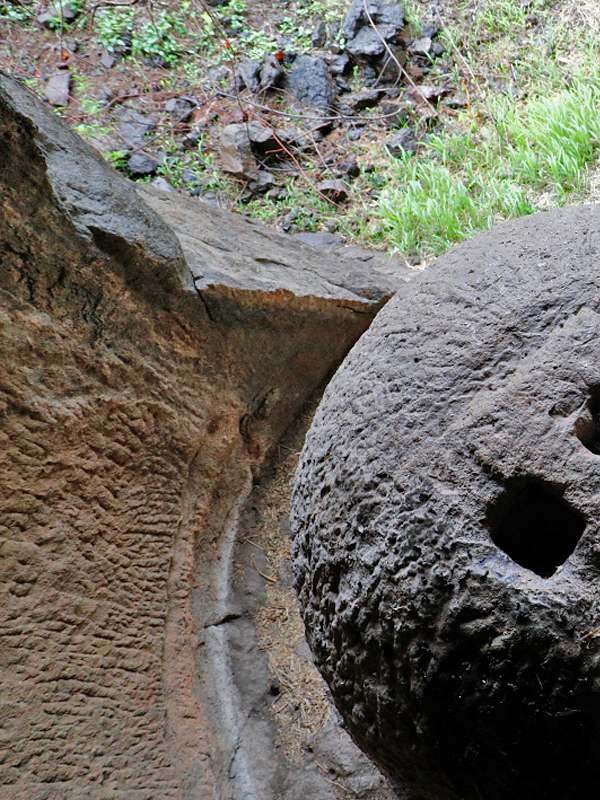 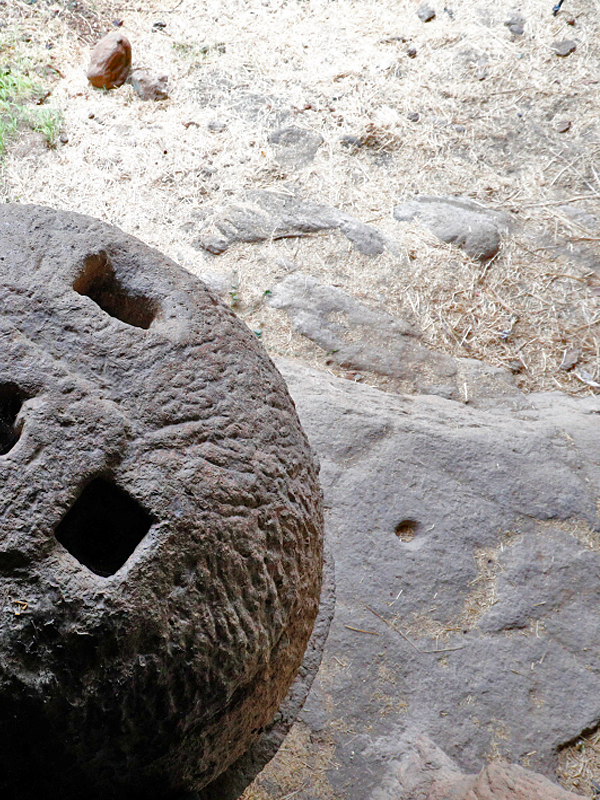 |
| |
| 19. Stupa/chaitya, Yelghol Cave, Maval Tehsil, Pune district, Maharashtra, India |
| |
|
|
| |
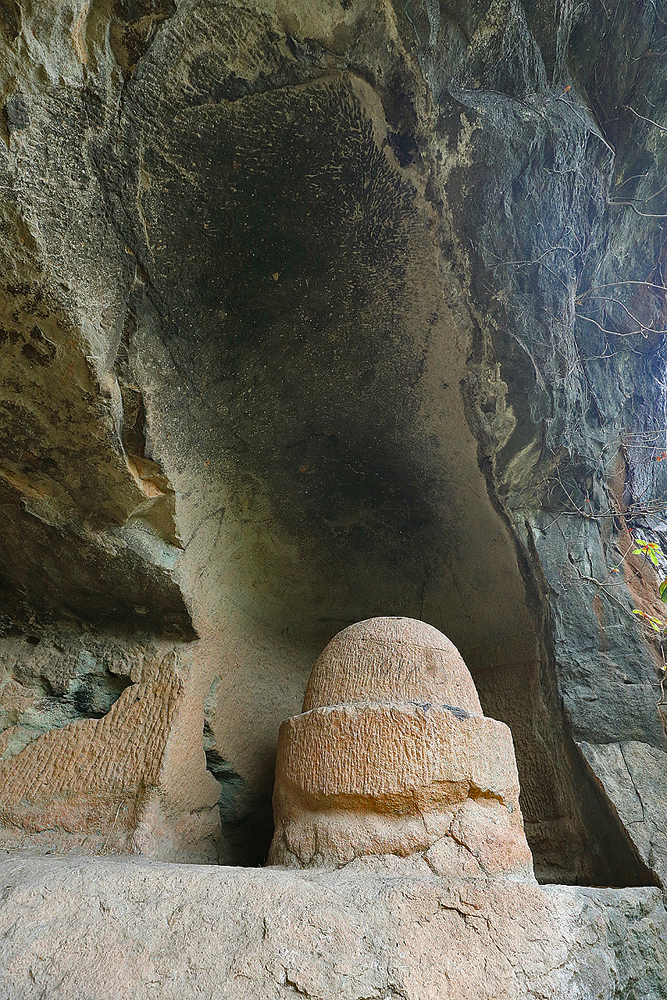 |
| |
| 20. Stupa/chaitya, Yelghol Cave, Maval Tehsil, Pune district, Maharashtra, India |
| |
|
|
| |
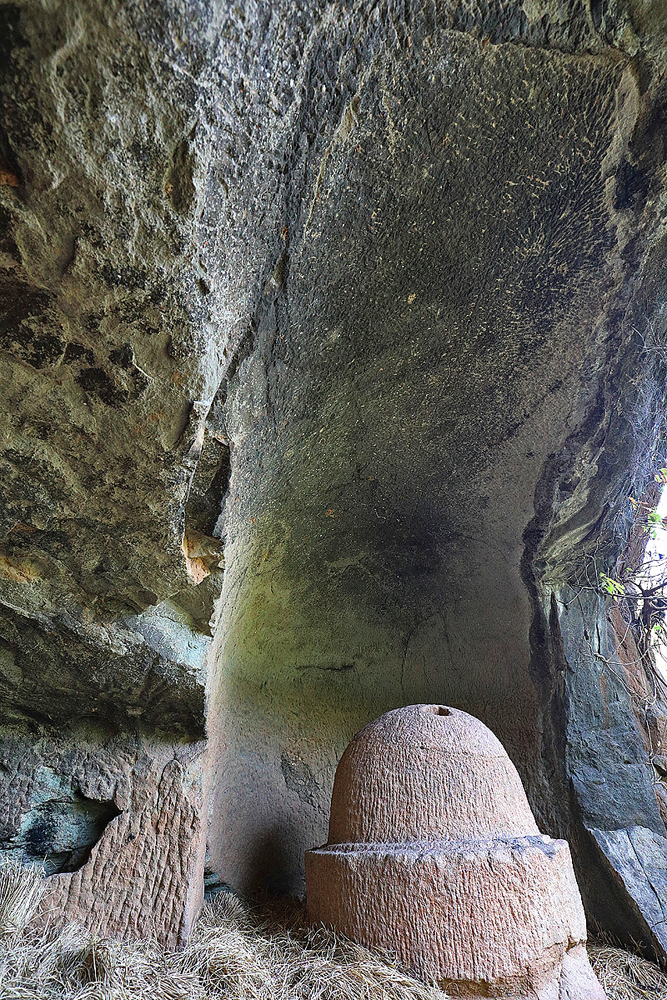 |
| |
| 21. Stupa/chaitya, Yelghol Cave, Maval Tehsil, Pune district, Maharashtra, India |
| |
|
|
| |
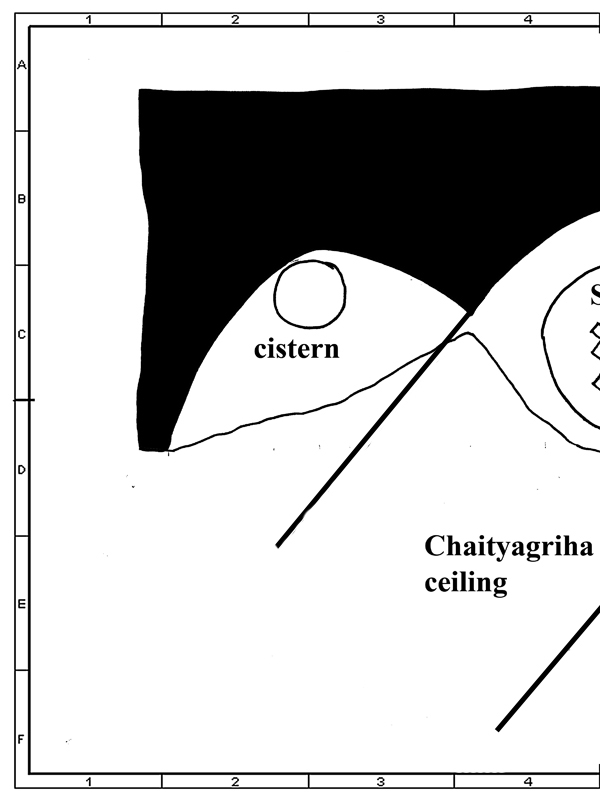 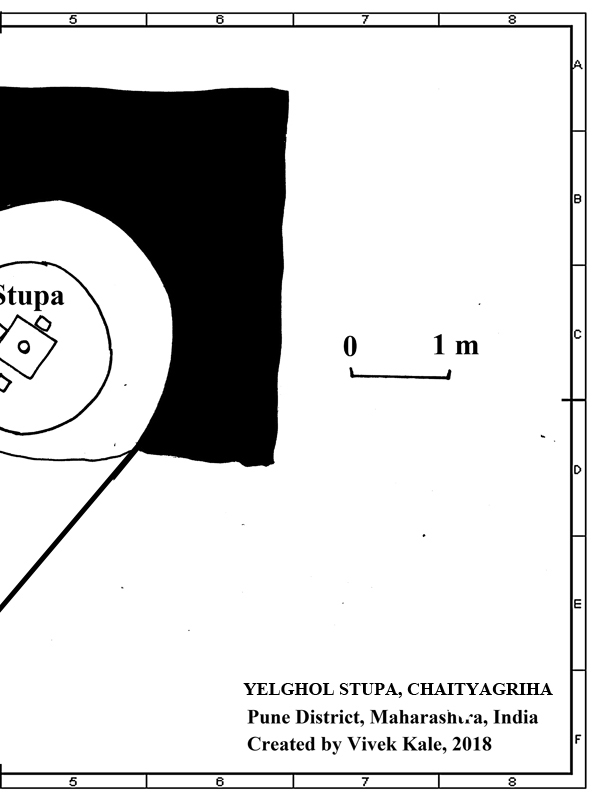 |
| |
| 22. Layout of Stupa/chaitya, Yelghol Cave, Maval Tehsil, Pune district, Maharashtra, India |
| |
|
|
| |
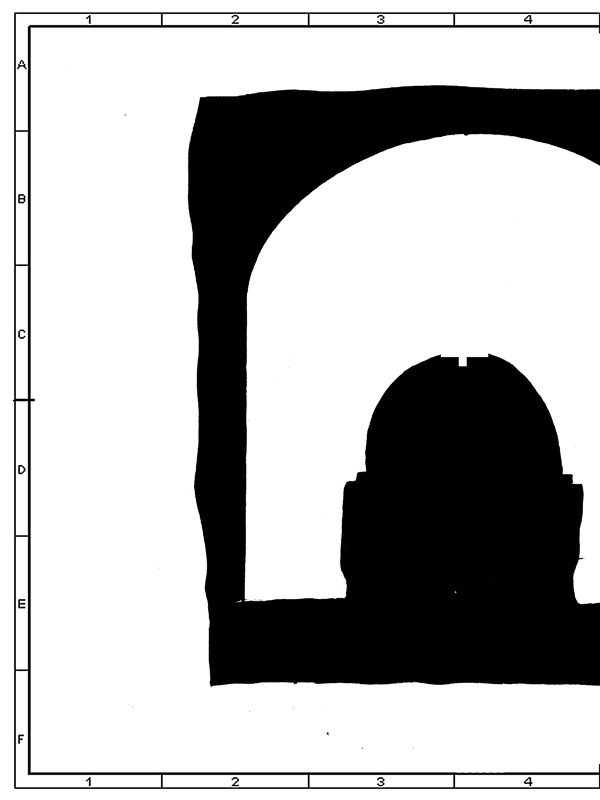 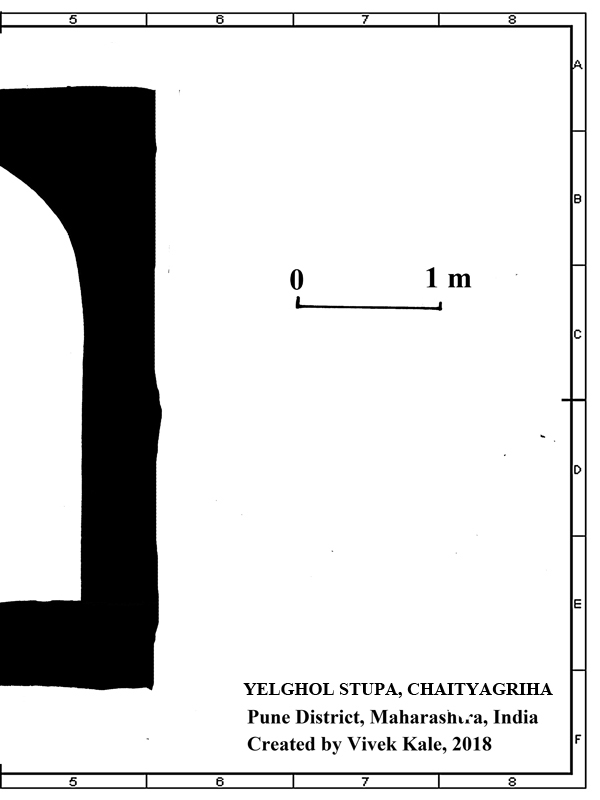 |
| |
| 23. Layout of Stupa/chaitya, Yelghol Cave, Maval Tehsil, Pune district, Maharashtra, India |
| |
|
|
| |
 |
| |
|
|
References :
1. Cave temples of India, London, 1880, Fergusson James and Burgess James.
2. Gazetters of Bombay Presidency, Poona District, Volume XVIII, 1885.
3. Buddhist architecture of western India, 1981, S. Nagraju.
4. Myth and Reality, Studies in the Formation of Indian Culture
by D. D. Kosambi
5. History and Society, Problems of Interpretation, by D. D. Kosambi
|
| |
|
|
| |
|


















































